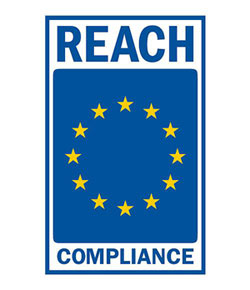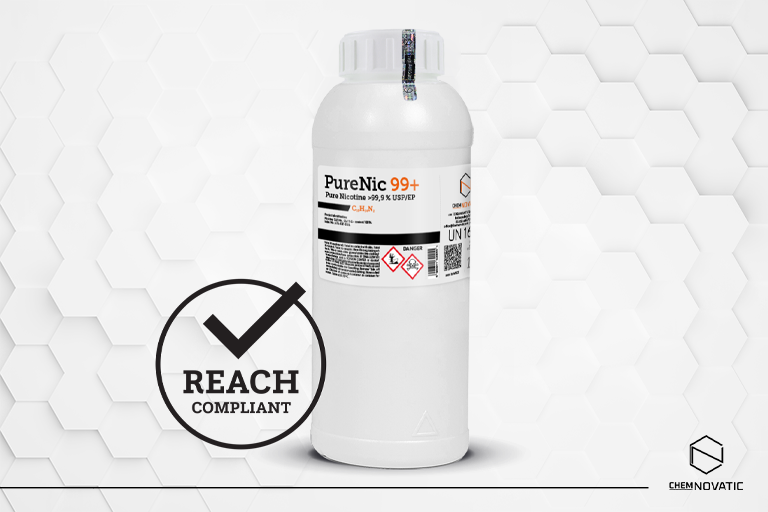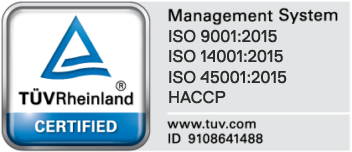REACH and CLP are two European Union regulations that apply to the chemical industry in general. However, as e-liquids are part of the chemical industry, they also fall under REACH and CLP. Let’s take a closer look at them, as they are among the most important e-liquid industry regulations.
See more:
- E-Liquid & Vape Industry Regulations [Knowledge Base]
- E-Liquid Regulations Guide: [Get Your Free E-Book]
- REACH: What Is Reach And Why We Talk About It?
- What Is UFI Code And How Does It Apply To The E-Liquid Industry?
- Excise Duty In The Vape Industry [Guide]
- TPD regulations
- What Is CLP?
1. E-liquid industry regulations – REACH
What is REACH?
REACH is one of the most important regulations of the European Union. It concerns a lot of chemical substances and affects many producers, importers, and downstream users. REACH has also an impact on our everyday life even if we don’t know about it. In what way? Let’s find out.
As a general rule, REACH applies to chemicals, but with some exceptions. Naturally occurring substances are not subject to registration REACH, unless they are dangerous, or have been chemically modified. REACH not only applies to chemicals of industrial processes but also to substances that occur in our daily lives. For example cleaning agents or paints, as well as components of many products such as clothing or furniture. This is why the regulation applies to most companies in the European Union. The regulatory body that is responsible for REACH is the European Chemical Agency (ECHA).
See also:
- Fees, Taxes And More: An Analysis Of Selected Regulations In Europe
- Flavoured E-Liquids Banned In The Netherlands
- Law And E-Liquid Regulations In Denmark
- Vaping Regulations In Australia
- What Brexit Means For Vaping Industry?
- Disposable E-Cigarette’s Sector In Latin America [Report]
- Vape Market In Portugal: A Brief Characteristic
- Vaping In Canada [Survey Report]
REACH vs. companies
First of all, companies must identify and control the risks associated with substances in the EU. Moreover, companies need to inform users on how to decrease possible risks when handling the substance or its mixtures. If risk management is not possible, the use of substances can be limited in many ways. In the longer term, companies should replace the most dangerous substances with less dangerous substitutes.
The REACH Regulation establishes procedures for collecting and evaluating the information on the properties of substances and the possible risks. Companies handling chemicals in the amount above 1 ton annually must register chemicals at the European Chemicals Agency. And to do this, these companies must cooperate with other companies registering the same substances.
REACH registration process
Let’s take a closer look at the REACH registration procedure on the example of pure nicotine. As it was mentioned before, a given company has an obligation to notify pure nicotine that it sells to the European Union if the amount of product is 1 ton or more annually. If you are an importer of a substance, you should add your registration to the registration of the main registrant.

You can make the registration on the REACH-IT website, using the IUCLID tool. To register, a manufacturer must collect and submit all data on the hazardous properties of substances. Then appropriate authorities evaluate the data. ECHA has to authorize substances of high concern such as carcinogens or mutagens. This ensures that risks from the use of such substances are either adequately controlled or justified.
REACH registration practical information
Each substance that passes evaluation and authorization is considered fully registered with REACH and is given a REACH Registration Number. After completing full registration you will be able to find and confirm your status on echa.europa.eu. You can see PureNic 99+’s REACH Registration Number on Safety Data Sheet.

The REACH registration includes an annual cost to share between all registrants. The principal registrant may charge administration fees at his discretion. If the cost of registration in a given year is lower, the lead registrant reimburses part of the cost corresponding to the other registrants.
Interestingly, outside the European Union, there are various relevant regulations corresponding to REACH. Other countries such as Turkey, Canada, or Korea adopted this idea to their own legislation.
Why REACH regulation is so important for the e-liquid industry?
Vaping companies must comply with REACH regulation in the sense that pure nicotine is a substance that falls under REACH.
Currently, companies that produce or import pure nicotine in quantities of more than 1 ton per year have to undergo a registration process. Sales of pure nicotine, which have not been pre-registered or registered, to the European market, is illegal. For this reason, it is a good idea to buy pure nicotine with the REACH registration number. Thanks to this, you will have a guarantee that it comes from a fully legal and reliable source.
Of course, our PureNic 99+ is fully REACH registered.
2. E-liquid industry regulations – CLP
CLP is a regulation resulting from the REACH.
It is an acronym that comes from words: Classification, Labelling, and Packaging.
As you know those three issues are very important for the chemical industry. Nowadays, it may be obvious that chemical product on a shop shelf has a label informing you about any threats.
This information and the way we display it on a product are subject to CLP regulation. Moreover, CLP aims to ensure a high level of health and environmental protection, as well as the free movement of substances, mixtures, and products.
CLP and its impact on the e-liquid industry
Substances and their mixtures can have different properties. Some of them can cause no harm to human health or the environment and some of them can be extremely hazardous. That is why the first step is to always define the possible hazard.
That kind of information is not only important for the end-user, but also for everyone who had to deal with it on the way. Starting from the producers, distributors, or even transporters and ending on consumers. Usually, in the EU, the chain of information starts with a manufacturer. However, if a company imports of the substance from outside of the EU this obligation can belong to the importer.
CLP affects labels
When the chemical (in our case – nicotine base, flavoring, or e-liquid) is correctly classified, you can start designing the label and select the appropriate packaging.
Depending on the threat level, the label of your product can have no extra marking or multiple mandatory pictograms, warning signs, hazard statements, and precautionary statements.
Regulations even cater to blind people, providing a warning sign in the form of a convex triangle in case if the chemical poses a threat or child-proof mechanisms when needed.
Moreover, designers must take into consideration all the above requirements when creating labels and packaging. Below you can see an example of pictograms on a NicShot packaging:
See also:
- E-Liquid Bottles Nozzle Requirements
- Nicotine Shots: Dealing With TPD Regulations
- NicSalt Shots vs. NicShots: Final Comparison
- TPD Compliant E-Liquid Packaging: Part 1
- TPD Compliant E-Liquid Packaging: Part 2
- POD Systems vs. Nicotine Salts And Their Growing Popularity
CLP vs storing, handling and transport
Further on the test results used to classify substances also help to identify the danger, it poses in transport, for example by road. And it helps to match the appropriate packaging so that the storage of the substance, as well as its transport, does not endanger the life and health of people and the environment.
Learn more:
- What Are E-Liquids? History And Business Opportunities
- Natural Vaping Products: Bases, Nicotine, Flavorings
- How To Start And Grow E-Liquid Brand?
- E-Liquid Manufacturing Standards: Tips For Producers And Brand Owners
- E-Liquid Manufacturers: Best Practices
- Safe Usage Of Chemicals [Guide]
- Storing And Handling Pure Nicotine And Nicotine Salts
- OEM Services And Private & White Label: 9 Reasons To Choose Chemnovatic As The Best Business Partner
Do You Need Any Help With Your Products? Just Contact Us!
If you need any advice regarding REACH, CLP and other regulations, our experts will talk to you with pleasure.
Please, send us a message at sales@chemnovatic.com
Let’s grow your business together!
Subscribe to our newsletter and receive a free access to our e-mail course on raw materials for e-liquids production (and more!).
No spam, only valuable content we promise to send you.






















hello ,anyone who can help me to apply the license of selling e-cigarette in poland?
Hi! Thank you for your asking. We’ve directed your question to the Customer Support Department, so, please, expect a message.